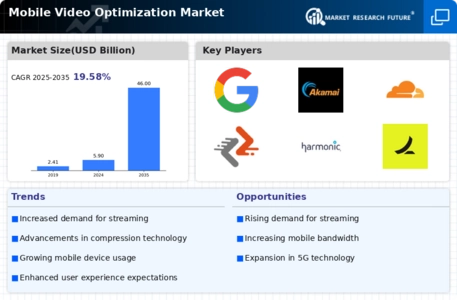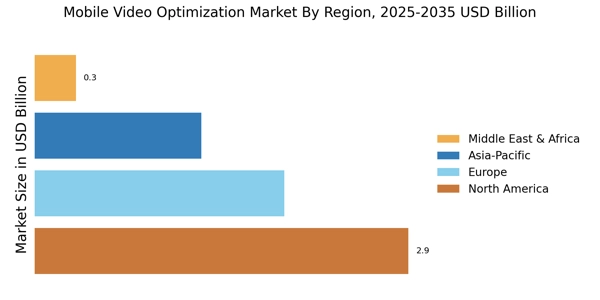Surge in Mobile Device Usage
The proliferation of mobile devices has catalyzed the Mobile Video Optimization Market. As of October 2025, it is estimated that over 80% of internet traffic is generated from mobile devices. This trend indicates a substantial shift in consumer behavior, with users increasingly relying on smartphones and tablets for video consumption. Consequently, businesses are compelled to enhance their video content for mobile platforms, ensuring optimal viewing experiences. The demand for high-quality video streaming on mobile devices has led to the development of advanced optimization technologies. These technologies aim to reduce buffering times and improve video quality, thereby enhancing user satisfaction. As mobile device usage continues to rise, the Mobile Video Optimization Market is likely to experience significant growth, driven by the need for seamless video playback across various mobile platforms.
Increased Focus on User Experience
The heightened emphasis on user experience is a crucial driver for the Mobile Video Optimization Market. As competition intensifies among content providers, delivering a superior user experience has become paramount. Research indicates that users are more likely to abandon videos that buffer or load slowly, which underscores the importance of video optimization. Businesses are increasingly investing in technologies that enhance video playback quality and reduce loading times, thereby improving overall user satisfaction. The Mobile Video Optimization Market is witnessing a surge in demand for solutions that prioritize user experience, as organizations recognize the correlation between optimized video content and user retention. This focus on user experience is likely to shape the future of the Mobile Video Optimization Market, as companies strive to create engaging and seamless video experiences for their audiences.
Growth of Video Content Consumption
The escalating consumption of video content is a pivotal driver for the Mobile Video Optimization Market. Recent statistics suggest that video content accounts for more than 70% of all online traffic. This trend is expected to persist, with projections indicating that video consumption will continue to rise in the coming years. As consumers increasingly favor video over other forms of content, businesses are recognizing the necessity of optimizing their video offerings for mobile platforms. The Mobile Video Optimization Market is responding to this demand by providing solutions that enhance video delivery and playback quality. Companies are investing in technologies that ensure videos are optimized for various mobile devices, catering to diverse user preferences. This growth in video content consumption is likely to propel the Mobile Video Optimization Market forward, as organizations strive to meet the evolving expectations of their audiences.
Advancements in Network Infrastructure
The continuous advancements in network infrastructure are significantly influencing the Mobile Video Optimization Market. The rollout of 5G technology is particularly noteworthy, as it promises to deliver faster data speeds and lower latency. This technological evolution is expected to enhance the mobile video streaming experience, allowing for higher resolution content and smoother playback. As of October 2025, many regions are witnessing the implementation of 5G networks, which is likely to drive the demand for optimized video solutions. The Mobile Video Optimization Market is poised to benefit from these advancements, as content providers seek to leverage improved network capabilities. Enhanced network infrastructure not only facilitates better video quality but also encourages the development of innovative optimization techniques. As a result, the Mobile Video Optimization Market is expected to thrive in an environment characterized by rapid technological progress.
Rising Popularity of Social Media Platforms
The increasing popularity of social media platforms is a significant catalyst for the Mobile Video Optimization Market. As users engage more with video content on platforms such as Instagram, TikTok, and Facebook, the demand for optimized video experiences has surged. Current trends indicate that social media platforms are prioritizing video content, with algorithms favoring video posts over static images. This shift compels businesses to adapt their video strategies to ensure compatibility with various social media formats. The Mobile Video Optimization Market is responding by offering solutions that enhance video quality and loading times, thereby improving user engagement. As social media continues to evolve, the need for effective video optimization will likely grow, driving further innovation within the Mobile Video Optimization Market. Companies that effectively leverage social media trends are expected to gain a competitive edge in this dynamic landscape.


















Leave a Comment